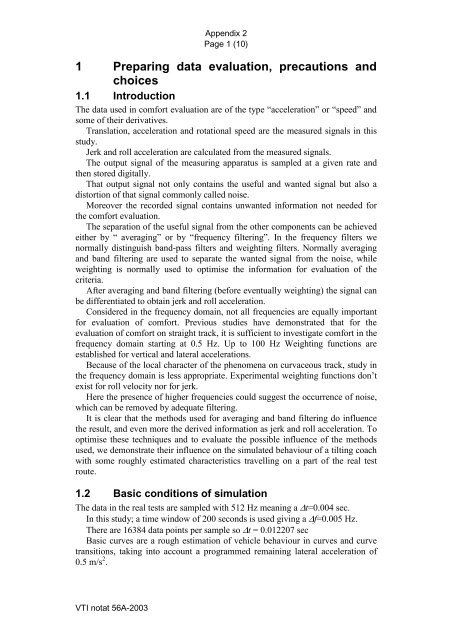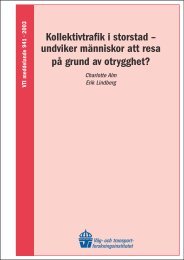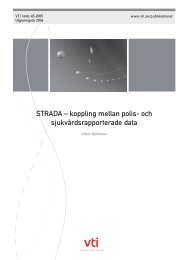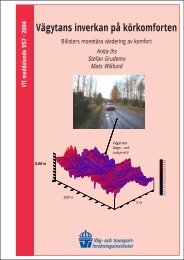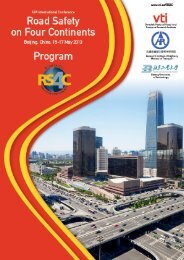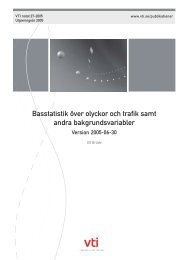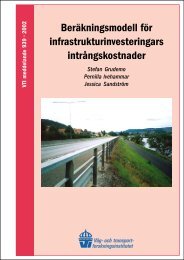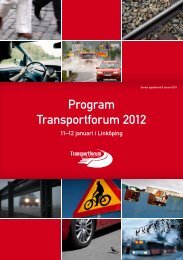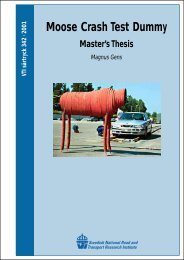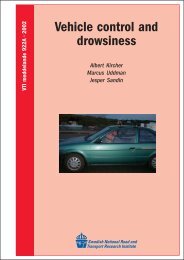UIC comfort tests - VTI
UIC comfort tests - VTI
UIC comfort tests - VTI
Create successful ePaper yourself
Turn your PDF publications into a flip-book with our unique Google optimized e-Paper software.
Appendix 2Page 1 (10)1 Preparing data evaluation, precautions andchoices1.1 IntroductionThe data used in <strong>comfort</strong> evaluation are of the type “acceleration” or “speed” andsome of their derivatives.Translation, acceleration and rotational speed are the measured signals in thisstudy.Jerk and roll acceleration are calculated from the measured signals.The output signal of the measuring apparatus is sampled at a given rate andthen stored digitally.That output signal not only contains the useful and wanted signal but also adistortion of that signal commonly called noise.Moreover the recorded signal contains unwanted information not needed forthe <strong>comfort</strong> evaluation.The separation of the useful signal from the other components can be achievedeither by “ averaging” or by “frequency filtering”. In the frequency filters wenormally distinguish band-pass filters and weighting filters. Normally averagingand band filtering are used to separate the wanted signal from the noise, whileweighting is normally used to optimise the information for evaluation of thecriteria.After averaging and band filtering (before eventually weighting) the signal canbe differentiated to obtain jerk and roll acceleration.Considered in the frequency domain, not all frequencies are equally importantfor evaluation of <strong>comfort</strong>. Previous studies have demonstrated that for theevaluation of <strong>comfort</strong> on straight track, it is sufficient to investigate <strong>comfort</strong> in thefrequency domain starting at 0.5 Hz. Up to 100 Hz Weighting functions areestablished for vertical and lateral accelerations.Because of the local character of the phenomena on curvaceous track, study inthe frequency domain is less appropriate. Experimental weighting functions don’texist for roll velocity nor for jerk.Here the presence of higher frequencies could suggest the occurrence of noise,which can be removed by adequate filtering.It is clear that the methods used for averaging and band filtering do influencethe result, and even more the derived information as jerk and roll acceleration. Tooptimise these techniques and to evaluate the possible influence of the methodsused, we demonstrate their influence on the simulated behaviour of a tilting coachwith some roughly estimated characteristics travelling on a part of the real testroute.1.2 Basic conditions of simulationThe data in the real <strong>tests</strong> are sampled with 512 Hz meaning a ∆t=0.004 sec.In this study; a time window of 200 seconds is used giving a ∆f=0.005 Hz.There are 16384 data points per sample so ∆t = 0.012207 secBasic curves are a rough estimation of vehicle behaviour in curves and curvetransitions, taking into account a programmed remaining lateral acceleration of0.5 m/s 2 .<strong>VTI</strong> notat 56A-2003


